MapInfo Exponare Public: Integration Guidelines
myData & MapInfo Exponare Public – Integration Overview
System Integration is two-way:
- Exponare Public deployment is embedded into myData
- Hyperlinks are embedded into Exponare to invoke myData
1. Create a Workspace for myData
Create a Workspace for myData using MapInfo Workspace Manager.
This Workspace should include any asset layers you want to link to myData, as well as any reference layers you want to display in addition to the asset layers.

Create a Workspace for myData using MapInfo Workspace Manager
2. Create a Work Context for myData
In Exponare Enquiry, open the Exponare Configuration Manager and create a new Work Context for the Workspace you just created.
Give this Work Context an appropriate name and reference it to the Workspace you created in the previous step.
Highlight the new Work Context and hit the Update Layer Settings button to load the Workspace layers into Exponare.
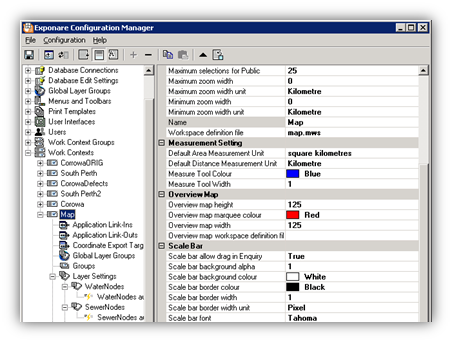
Create a Work Context for myData and Update Layer Settings
Delete all of the auto-generated Data Binds as these don’t really include any information required for integration.
Select each Data Bind from the tree on the left and hit the ‘–‘ button to remove it from the Work Context.

Delete the auto-generated Data Binds by highlighting them and clicking the ‘–‘ button
3. Achieving a link from myData to Exponare Public
To allow myData to select an asset in Exponare Public, you will need to add a new query to each layer you want to link to myData.
- Go to the Queries section under your Work Context and add a new query.
- Choose “Active Selection” next to After query is run zoom to
- Give the query a Name (e.g. “RoadsQuery” or “BuildingsQuery”).
- Enter a Description (e.g. “Get Building”).
- Select the relevant layer for the Selection layer.
- Enter a SQL template with a query similar to this: Select mi_key from Buildings where Asset_ID = @ID (where Buildings refers to the relevant layer in the MapInfo Workspace, Asset_ID is the field in the MapInfo table which matches the Asset ID in myData, and ID refers to the Query Parameter).
- Enter a User text template (e.g. “Enter Asset ID: {ID}” - the ID in curly brackets refers to the Query Parameter we will create in the next step.
- Change the Database connection to “Native”.
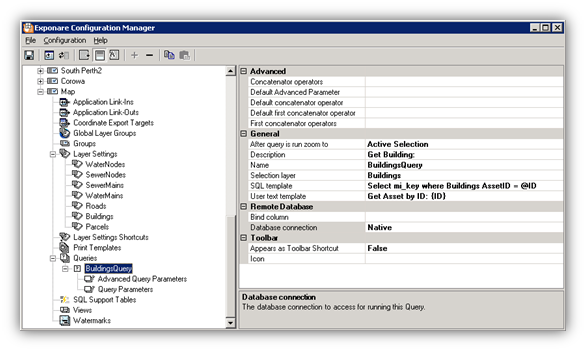
Enter the query details.
Add a Query Parameter to the query you just created.
- Set the Data type to match the field in the MapInfo table
- Choose “Native” for the Database connection
- Under Input type, select “Text Input”
- Give the Query Parameter a Name to match what was entered in the previous step (e.g. “ID”)
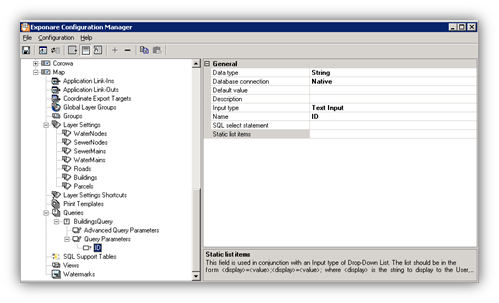
Enter the Query Parameter details
4. Achieving a link from Exponare Public to myData
To allow Exponare Public to link back to myData, you will need to create a custom Data Bind for each layer you want to link.
To create a custom Data Bind, you can select the desired layer and hit the ‘+’ button.
Add the following information to the Data Bind:
- Set Databind Expanded by Default to “True”
- Enter a Description (optional)
- Set Execution Mode to “Always”
- Enter a Name (e.g. “MyData Building Redirect” or “MyData Road Redirect”)
- Enter the following SQL query:
- Select mi_key, ID as "MyData ID", 'redirect.html?assetCategory=SealedRoads&assetID=' + ID "MyData Hyperlink", 'Selected Asset' "MyData Link" From "Roads_Selection" (where ID is the field in the MapInfo table which matches the Asset ID field in myData, SealedRoads is the database table name for the asset category in myData, MyData Hyperlink is the name which will be used to create a hyperlink in the next step, and Roads is the layer name in the MapInfo workspace).
- Set the Database connection to “Native”
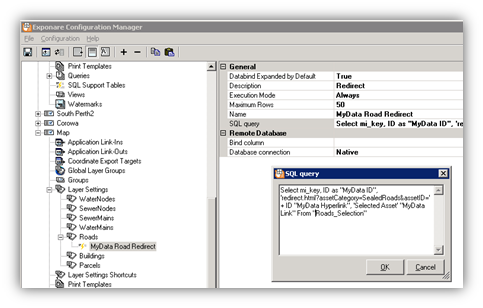
Create a custom Data Bind for each layer you want to link to myData
To complete the process, highlight the newly created Data Bind and hit the ‘+’ button.
This will create a new hyperlink where you can enter the following information:
- For Active column, enter “MyData Hyperlink” (note that this should match the hyperlink name added the SQL query in the previous step).
- Enter a Display column name (e.g. “MyData Link” - this will be the text displayed in the hyperlink)
- Enter a Name for the hyperlink (e.g. “MyData Hyperlink”)
Once Data Binds and Queries have been created for all of the relevant asset layers, Exponare Configuration as complete so please ensure that you save the configuration.
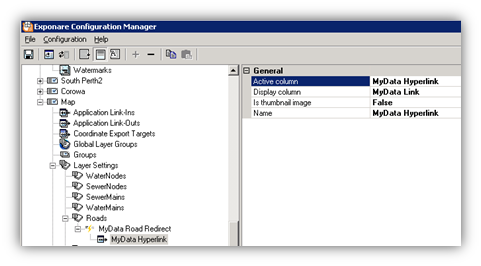
Add a hyperlink to each Data Bind
To ensure that Exponare can communicate with myData, you will need to request the relevant files from Assetic.
These files – redirect.html and myDataRedirect.js. - need to be pasted into the Exponare Public install directory e.g. C:\Program Files\MapInfo\Exponare\Server.
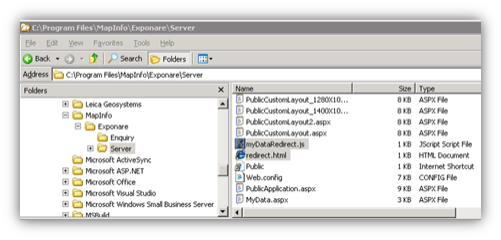
Paste the supplied files into Exponare Public’s install directory
5. Configuration in myData
To unlock the Exponare Public plugin for myData, Assetic must activate this feature in your license file.
You must ensure that your license allows access to the plugin before proceeding.
To check, open myData and go to Tools>Integration and GIS, licensed plugins will appear in the Supported Products list.
Highlight the MapInfo Exponare Public entry under Supported Product and hit the Add button to add a new map instance to myData.
Give your map instance a name before hitting the Edit button.
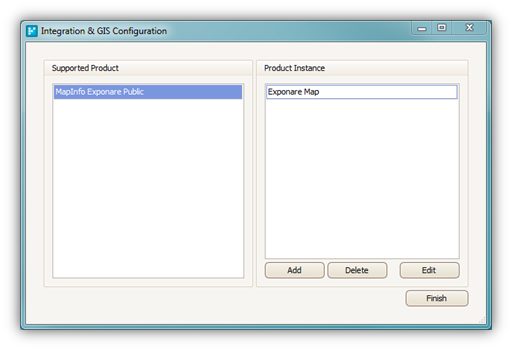
Open the GIS Configuration dialogue and add a new map instance
You will be taken to the Product Instance Configuration dialogue where you can add the following information.
Under the Server Settings tab:
- Server URL: the http/s address where Exponare Public is installed
- Application Page: the application page to launch Exponare Public
- Invoker Page: the Exponare Public invoker page
- Work Context: the name of the Work Context you created for myData
If authentication is required, please fill in the Username and Password fields (note that you will need to set up a single Exponare user account for all myData users).
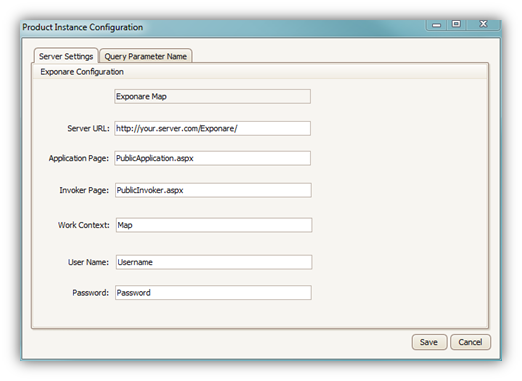
Product Instance Configuration – the Server Settings tab
Under the Query Parameter Name tab, enter the following information against each Asset Category you want to link to Exponare:
- Query Name: the name of the Query created in Exponare (e.g. BuildingsQuery, RoadsQuery)
- Query Parameter Name: the name of the ID parameter (it’s easiest to keep this as ID for all instances in Expoanre)
Please note that Query Name and Query Parameter Name are both case-sensitive.
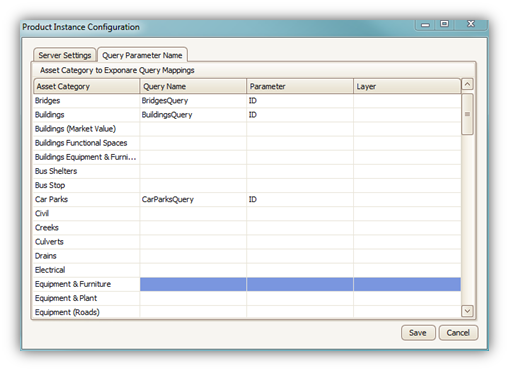
Product Instance Configuration – the Query Parameter Name tab
